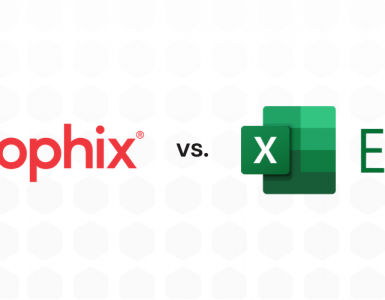What separates leading Finance teams from the rest of the pack? What should you do to build speed, agility and resilience into your planning, budgeting and forecasting (PBF) processes?
To answer these questions, FSN Publishing Limited (FSN) and Prophix recently conducted a global survey of over 500 finance leaders. We hoped to find out what the most successful Finance departments had in common, but even we were surprised at how clear the results were.
To get the full story, we spoke to the Chief Executive of FSN, Gary Simon, who headed up the research. Read on for insights into the survey results and what finance leaders can do to make PBF more agile and accurate.
The Direct Link Between Transformation and Agility
“I wasn’t expecting to be able to show how transformation leaders did so much better than their contemporaries who hadn’t started on the transformation journey,” says Gary.
“It wasn’t just isolated, you know, a little bit over here and a little bit over there. It was right across the board — be it speed, be it accuracy, be it the ability to look out further on the horizon, be it the ability to change aspects of the reporting.”
But, according to the survey, only about one-third of finance leaders have made significant efforts to transform PBF, with just 5% claiming to have completely transformed their financial processes.
So, what’s needed to move your transformation efforts forward? Gary points to two things: A robust infrastructure and new accounting techniques.
Building the Infrastructure with Relevant and Trustworthy Data
“You can’t do any of the things you need to do unless you’ve got complete mastery of your data,” Gary says.
According to the survey, senior finance executives agree on the pivotal importance of data — 84% say that improving the relevance of captured data is the most fundamental area that needs to change to improve agility. But it’s not just about capturing the data. There is also the need to leverage the findings in a meaningful way.
And for that, companies likely need a specialized application that can be easily accessed and expanded. Gary says that organizations “will save a lot of time by moving to web-based — or even an on-premise — process if you’ve got direct access to the data repository.”
Once you have easy access to reliable data, you’ll have the foundation for the best accounting techniques. “But, to underline the point, you absolutely cannot do what needs to be done in a spreadsheet,” Gary says.
Accounting Techniques Needed for Speed, Agility and Accuracy
The survey looks at organizations using rolling forecasts, zero-based budgeting (ZBB) and scenario planning to see how these capabilities affect speed, ability, and accuracy in financial planning and budgeting.
“You have to have an agile forecasting process in order to flex your approach according to the circumstances you face at a particular moment in time,” Gary says. “Our research identified that you need to dip into each of those techniques in an appropriate way. These three techniques all improve the process, but they bring different attributes to the party.”
Rolling Forecasts for Superior Agility
The survey shows that 80% of finance executives can’t forecast beyond one year — and it’s a problem for companies of all sizes.
Rolling forecasts can shift the odds. FP&A groups that use this accounting technique add a period of time to the end of the forecast each time a period drops off, ensuring that the company is always looking at least twelve months ahead.
“So, you have agility built-in as well as the ability to be more accurate, quicker and look out a little bit further than you would normally be able to do,” Gary explains.
Twelve-month rolling forecasts are used by between 19% and 25% of companies, and these businesses drastically outperform those who reforecast four times a year.
The survey finds that using rolling forecasts strengthens a company’s ability to change processes, shortens the time needed for forecasting and improves accuracy. But being effective with rolling forecasts requires ditching the spreadsheets and embracing new systems and processes.
“What shocked me was the ease with which we were able to draw a straight line between transformation and agility,” Gary said.
Zero-Based Budgeting for Greater Accuracy
ZBB is what it sounds like — it’s starting from ground zero when building your budget. And, it can drastically improve the accuracy of your forecasts.
“Zero-based budgeting makes the assumption that you’re going to start afresh, that you’re not going to take last year’s budget and tweak it up or down a few percent,” Gary explains. “Having a blank slate means you can cut out all the clutter, all the assumptions, and all the stuff that’s carried over year after year — including all those mystery line items that no one can explain.”
Does this sound like a lot of work? It can be. So, it’s no wonder that there is hesitancy to use ZBB. According to the survey, only 13% of organizations use this accounting technique for all areas of their business, and 32% don’t use ZBB at all.
But by forgoing ZBB, companies are missing out on a potentially big payoff. The survey finds that companies using ZBB have superior performance across all the PBF processes. Eighty-four percent can reforecast in under a week, and they are about twice as likely as ZBB holdouts to have earning and revenue forecasts which are accurate to +/- 5%.
“If you want more accuracy, you need to go zero-based budgeting, but it’s quite a difficult exercise. It’s not something you entertain lightly,” Gary says.
Scenario Planning for Future Resilience
Gary describes scenario planning as “a strategic view of the business, looking at assumptions, [and] taking in a wide range of external stimuli and internal data that will influence how the market will look in the longer term.”
The value of scenario planning plays out in the data. For example, 77% of finance leaders who consider multiple scenarios can reforecast earnings within one week, compared to 41% who do not. And companies that use scenario planning are also able to forecast with a much higher degree of accuracy.
Because scenario planning is hard to do without specialist software, companies who use scenario planning usually are further along in the transformation process. However, at this point, just 4% of organizations make scenario planning a priority – a massive opportunity for improvement.
Making Your Case for Investing in Transformation
Without the proper infrastructure, technology and processes, finance leaders can only get so far. While many organizations don’t prioritize investing in backend finance systems, the pandemic illuminated the need for transformed PBF processes. The good news, according to Gary: “There’s never been a better time for CFOs to persuade their colleagues to invest.”
The pandemic put financial leaders in the spotlight as companies tried to stay ahead of the ever-changing situation. Processes for forecasting and approvals profoundly changed, providing the rest of the C-suite a glimpse into what Gary calls “the agony and the ecstasy of working with Finance.”
“We’re at the point where finance leaders can say to the rest of the C-suite, ‘You don’t need to see a large report from us saying why we need to invest in new systems, you’ve seen it. So let’s go ahead and invest,” Gary says.
Read the Survey Results to Learn Much, Much More
Transformation in finance planning and analysis can be slow going — but the organizations embracing change are getting ahead. View the full survey results to discover the links between transformation and results.
The Agility in Planning, Budgeting and Forecasting Global Survey 2021 survey was sponsored by Prophix Software. This company helps mid-market companies achieve their goals more successfully with innovative, cloud-based Corporate Performance Management (CPM) software.






